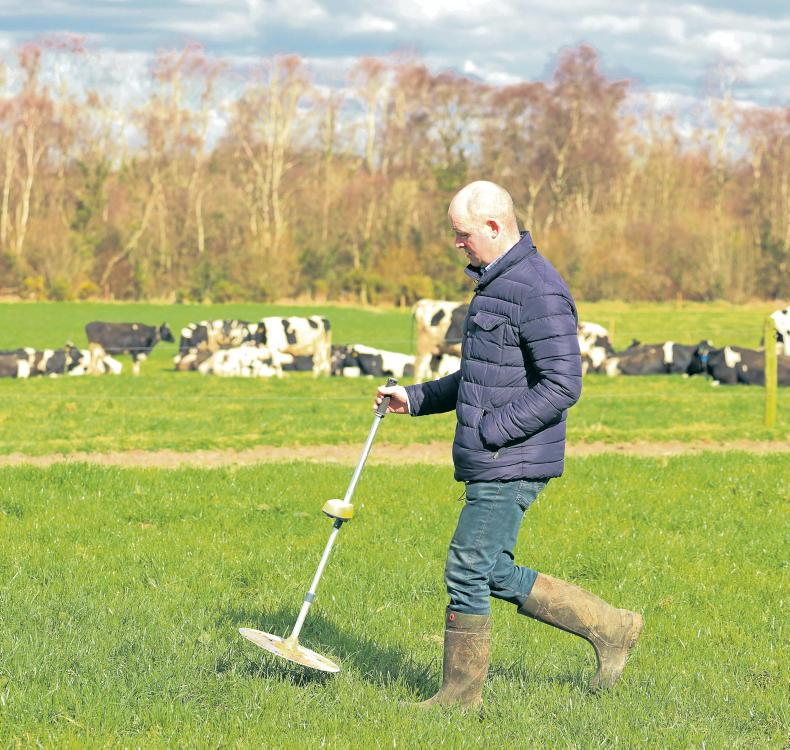Married to Áine, Stephen Byrne also have two sons, Tom and Jim. Last year, the farm averaged just over 6,500l/cow, 540kg milk solids and had a somatic cell count of 70,000. Calving began on the farm in the last week of January and is due to be finished in early April.
Genetics
Due to limited land availability for rent in the area, Stephen focuses on optimising production and profitability through superior genetics.
The farm is a registered pedigree Holstein Friesian herd since last year and has an average EBI of €215, with a focus on breeding for milk solids and fertility. Stephen uses a team of six carefully chosen high-EBI bulls each year.
Calves are sold at two to three weeks of age and 25 heifer calves are retained as replacements. The heifers, along with approximately 20 cows, are inseminated with sexed semen, while timing of AI is determined by collars.
Last year, 65 sexed semen straws were used, resulting in an impressive 43 heifer calves and just one bull calf.
The farm invested in collars last year, replacing tail paint and scratch cards. This has significantly reduced workload, increased accuracy in heat detection and made managing herd health easier.
All calves are genomically tested, giving an insight into their genetic potential, allowing Stephen to make informed breeding decisions to further advance his herd. The breeding season begins in the last week of April, lasting for 12 weeks.
Animal health

Stephen appreciates the importance of effective grass management.
Monthly milk recording allows Stephen to track somatic cell count (SCC) and individual cow performance, ensuring timely intervention when needed. Using milk recording data, Stephen has successfully reduced his antibiotic usage through selective dry cow therapy.
Cows with an SCC of over 100,000 receive an antibiotic dry cow treatment, while the remainder of the herd are given teat sealer only.
This targeted approach has resulted in a reduction in the use of antibiotics by two-thirds, with only 35 cows requiring treatment last year.
The herd is vaccinated against salmonellosis, neonatal calf diarrhoea, leptospirosis and IBR. Stephen’s proactive approach to animal health is evident in his comprehensive health programme and constant monitoring of performance.
Nutrition
Stephen prioritises early turnout to grass and strategic supplementation to maximise milk solids. Cows are out to grass by day in February and are fully turned out in mid-March, remaining at grass until early November, depending on weather.
Cows are buffer-fed on the shoulders of the grazing season to sustain production. They are given alkalage on their second round of grazing. This helps maintain their milk solids production, preventing butterfat suppression.
Just over 10t DM/ha of grass was grown on the farm last year and cows were fed an average of 1.4 tonnes of meal. The land is soil sampled regularly and a nutrient management plan is developed. Fields low in P and K are targeted with slurry.
To ensure resilient and productive swards, 10% of the farm is reseeded annually, equating to approximately 10 to 15 acres. The inclusion of white clover in the reseeded mix and the sowing of red clover for silage has resulted in a reduction of chemical nitrogen dependency.
All silage is baled and cut from the middle of May, with dry matter digestibility ranging from 68% to 73% last year.
“Stephen is doing a top-class job. He never cuts corners on any aspect of his system. Attention to detail and acting on advice is something he executes well. Stephen is always looking to improve efficiency and productivity on his farm, particularly through breeding and nutrition,” said local vet Karen Larke, Larke Veterinary.
Four key pillars of profitabilityThe Technology For Profit competition is aimed at innovative dairy farmers who are using technology to maximise their profitability by focusing on the four key pillars of production: nutrition, genetics, management and animal health.
For this competition, a panel of judges went on farm to assess the farm’s level of productivity and profitability. The overall winner will be selected from this on-farm assessment.
Married to Áine, Stephen Byrne also have two sons, Tom and Jim. Last year, the farm averaged just over 6,500l/cow, 540kg milk solids and had a somatic cell count of 70,000. Calving began on the farm in the last week of January and is due to be finished in early April.
Genetics
Due to limited land availability for rent in the area, Stephen focuses on optimising production and profitability through superior genetics.
The farm is a registered pedigree Holstein Friesian herd since last year and has an average EBI of €215, with a focus on breeding for milk solids and fertility. Stephen uses a team of six carefully chosen high-EBI bulls each year.
Calves are sold at two to three weeks of age and 25 heifer calves are retained as replacements. The heifers, along with approximately 20 cows, are inseminated with sexed semen, while timing of AI is determined by collars.
Last year, 65 sexed semen straws were used, resulting in an impressive 43 heifer calves and just one bull calf.
The farm invested in collars last year, replacing tail paint and scratch cards. This has significantly reduced workload, increased accuracy in heat detection and made managing herd health easier.
All calves are genomically tested, giving an insight into their genetic potential, allowing Stephen to make informed breeding decisions to further advance his herd. The breeding season begins in the last week of April, lasting for 12 weeks.
Animal health

Stephen appreciates the importance of effective grass management.
Monthly milk recording allows Stephen to track somatic cell count (SCC) and individual cow performance, ensuring timely intervention when needed. Using milk recording data, Stephen has successfully reduced his antibiotic usage through selective dry cow therapy.
Cows with an SCC of over 100,000 receive an antibiotic dry cow treatment, while the remainder of the herd are given teat sealer only.
This targeted approach has resulted in a reduction in the use of antibiotics by two-thirds, with only 35 cows requiring treatment last year.
The herd is vaccinated against salmonellosis, neonatal calf diarrhoea, leptospirosis and IBR. Stephen’s proactive approach to animal health is evident in his comprehensive health programme and constant monitoring of performance.
Nutrition
Stephen prioritises early turnout to grass and strategic supplementation to maximise milk solids. Cows are out to grass by day in February and are fully turned out in mid-March, remaining at grass until early November, depending on weather.
Cows are buffer-fed on the shoulders of the grazing season to sustain production. They are given alkalage on their second round of grazing. This helps maintain their milk solids production, preventing butterfat suppression.
Just over 10t DM/ha of grass was grown on the farm last year and cows were fed an average of 1.4 tonnes of meal. The land is soil sampled regularly and a nutrient management plan is developed. Fields low in P and K are targeted with slurry.
To ensure resilient and productive swards, 10% of the farm is reseeded annually, equating to approximately 10 to 15 acres. The inclusion of white clover in the reseeded mix and the sowing of red clover for silage has resulted in a reduction of chemical nitrogen dependency.
All silage is baled and cut from the middle of May, with dry matter digestibility ranging from 68% to 73% last year.
“Stephen is doing a top-class job. He never cuts corners on any aspect of his system. Attention to detail and acting on advice is something he executes well. Stephen is always looking to improve efficiency and productivity on his farm, particularly through breeding and nutrition,” said local vet Karen Larke, Larke Veterinary.
Four key pillars of profitabilityThe Technology For Profit competition is aimed at innovative dairy farmers who are using technology to maximise their profitability by focusing on the four key pillars of production: nutrition, genetics, management and animal health.
For this competition, a panel of judges went on farm to assess the farm’s level of productivity and profitability. The overall winner will be selected from this on-farm assessment.








 This is a subscriber-only article
This is a subscriber-only article





